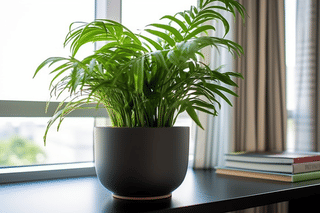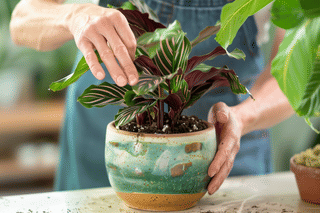Do plants grow better in plastic or ceramic pots?
Wondering whether your plants will thrive better in plastic or ceramic pots? Join me in this friendly guide where I share simple tips and insights to help you choose the right pot for your leafy friends. Let's explore together how the right container can make all the difference in keeping your plants happy and healthy!
If you're looking for new pots for your plants, you will have seen a few different types of pots: ceramic, plastic, terracotta, and perhaps even some concrete ones. I've explained the difference between plastic and terracotta before, so in this post, we'll look at plastic versus ceramic pots. Why? Because these two types of pots are pretty similar and it's not instantly clear why one is better.
So let's look at the differences and see which is better for your plant!
Why plastic pots are good for plants
Plastic pots come with a few advantages that make them a favorite for many plant lovers. First off, they're lightweight and easy to move around. If you enjoy arranging your plants, plastic pots are your best friend! They're also budget-friendly, allowing you to fill your space with plants without breaking the bank.
Another great thing about plastic pots is that they usually have drainage holes. This means water can flow out easily, helping to prevent overwatering. And perhaps the most important benefit: There are so many different styles. You'll find plastic pots in all sorts of colors and sizes, allowing you to pick ones that suit your style perfectly.
Why ceramic pots are good for plants
Ceramic pots, on the other hand, are all about appearance and function. They often look incredible and making your plant stand out. Besides looking great, they also help to insulate the plant's roots. They help maintain a stable soil temperature, even with larger temperature changes.
While ceramic pots can be heavier, that weight can actually be a good thing. It helps keep larger plants stable and less likely to tip over. If you take care of these pots, ceramic pots are durable and can last a long time.
Now that we've looked at some of the most important benefits of each of these plants, let's compare these plants a little further.
Biggest differences between plastic and ceramic pots
When choosing between plastic and ceramic pots, it's good to look at how they manage drainage and temperature.
Drainage
Plastic pots often come with excellent drainage holes, allowing excess water to flow out easily. Ceramic pots can also have drainage, but some decorative types might not, so watch out for that.
Temperature
In terms of temperature, ceramic pots generally provide better insulation, helping to maintain stable soil temperatures. They keep the soil cooler in hot weather and retain warmth during chilly nights. Plastic pots, while lighter and quick to heat up, can cool down just as fast, which might not be ideal for plants in areas with extreme temperature shifts.
Weight
Weight and longevity are also crucial factors. Plastic pots are lightweight and easy to move, making them perfect for those who like rearranging their plants. However, ceramic pots tend to be heavier, which can help keep larger plants steady.
Long-term use
In terms of durability, ceramic pots outlast plastic ones and can handle outdoor conditions better, although they cost more upfront. Plastic pots are budget-friendly and perfect for adding more plants without stretching your wallet.
Environmental impact
Lastly, think about environmental impact and customization. Plastic pots can be less eco-friendly due to potential waste, while ceramic pots, made from natural materials, are the greener choice.
Customization
If you enjoy personalizing your plant pots, plastic ones are easier to customize with paint or designs. In contrast, ceramic pots can be harder to modify, but their beauty makes them a stylish option for any home.
What do plants like best?
Certain types of plants may like one pot material over the other! For example, plants that thrive in drier conditions, like succulents and cacti, often do well in plastic pots because of their good drainage. These plants don't like to sit in water, so the lightweight plastic options are usually a great fit.
On the other hand, moisture-loving plants, such as ferns and tropical plants, might benefit more from ceramic pots. The insulation provided by ceramic can help keep the soil temperature steady and moist, which these plants love. Plus, if you remember to choose a ceramic pot with drainage, you'll create a comfortable environment for those water-loving greens!
Thank you for reading this post! I hope it helps you to keep your plants healthy and beautiful! If you're looking for more guides on specific plants, you can always request a plant guide to get a guide for the plant you have trouble with.
Test your plant care knowledge
Quiz completed!
Want to learn more? Sign up for my newsletter to receive free tips in your inbox!
Sign up now!












